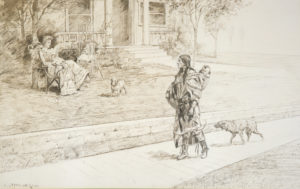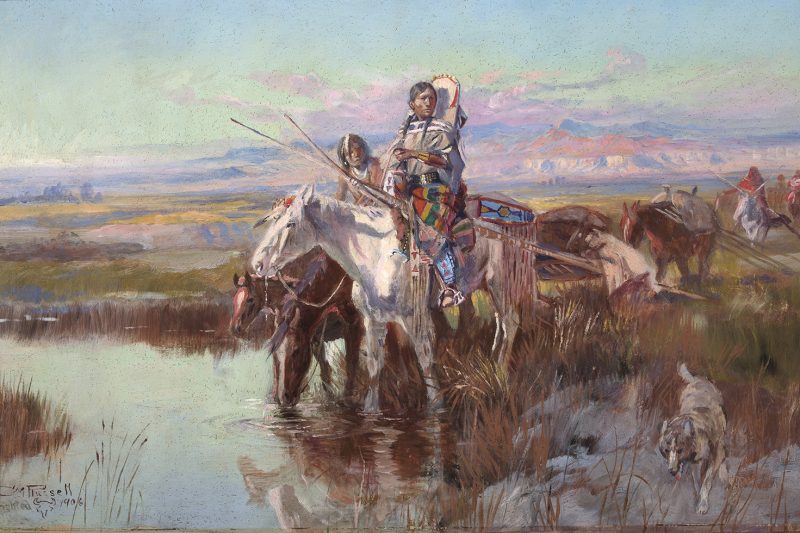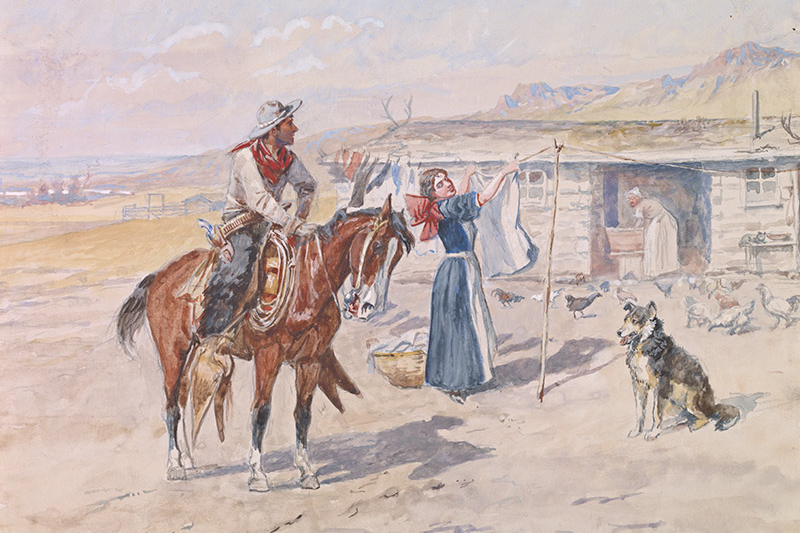
A new exhibit at the C.M. Russell Museum in Great Falls, “Charles M. Russell: The Women in His Life and Art, offers a fresh look at the artist and the women who influenced him.
The groundbreaking exhibit, on display May 18-Sept. 30, features 60 works in oil, watercolor, pen and ink and bronze by Russell that span the length of his career from 1890 to 1926. Additional works by notable artists who influenced his depictions of women are also on display.
The American West is traditionally thought of as a man’s world, a view that has been maintained and glorified by generations of novelists and artists who have staked their careers on interpreting and visualizing the west. While Russell is recognized as one of the premier interpreters of that masculine domain, it is one that has overshadowed the artist’s portrayals of women in the west, a subject that spans the entirety of his career.
Russell depicted a surprisingly large number of women in his work, fulfilling an expansive range of western roles. Some of these roles – white women as pioneer wives, captives of hostile Indians, or prostitutes, or Indian women as exotic sex objects and domestic drudges – conform to the pervasive stereotypes and artistic trends of his time. However, Russell’s experience and observation in the late 19th-century West encouraged more nuanced and action-oriented depictions of women than did many of his contemporaries, and he often incorporated female subjects in his ongoing commentary on progress and change in the West and its effects on western people.
The classic study of the artist’s portrayals of women is Ginger K. Renner’s essay, “Charlie Russell and the Ladies in His Life,” which appeared in Montana: The Magazine of Western History in 1984. While Renner’s work laid a comprehensive, well-illustrated foundation for future scholars, many of whom incorporated her insights on women into their own Russell narratives, there has yet to be another such sustained examination of Russell and the women in his art.
“Charles M. Russell: The Women in His Life and Art” honors Renner’s contribution by examining Russell’s life and work in the context of the women who encouraged his creativity and helped shape his career. From his mother and paternal grandmother to his wife, close friends, and professional colleagues, the women who surrounded Russell helped shape his artistic vision of the West as well as his conception of the place of women within it.
Many of the women closest to him played the role of muse, inflecting his art in their capacity as models, tastemakers, and partners in dreaming. It is the substance and character of these women, along with the cultural trends, mores, and views of women typically associated with the turn-of-the-century America shaped Russell’s artwork.
The exhibition is co-curated by Joan Carpenter Troccoli, curator emeritus at the Denver Museum of Art, and Emily Crawford Wilson, curator of the C.M. Russell Museum. An accompanying catalogue to the exhibition will feature three new essays – by Troccoli, Wilson, and Jennifer Bottomly O’looney of the Montana Historical Society – with a foreword by Brian Dippie, emeritus professor at the University of Victoria, British Columbia, and commentary from Nancy Russell’s unpublished biography, selected and annotated by Thomas Petrie, board chair of the C.M. Russell Museum.
An array of special events accompany the exhibit, including docent-led public tours at 2 p.m. Tuesdays, Fridays and Saturdays, June 5-Aug. 31.
Other offerings:
- Member Preview, 5 p.m. May 18: Join other museum members for an exclusive look at the new exhibition with introduction by co-curators Emily Wilson and Joan Troccoli. Four of the five essayists from the exhibition catalogue will also be on-hand for a book signing.
- Nancy Josephine Clark, “Josie: The Blackfoot Woman in C.M. Russell’s Life,” 6 p.m. May 19: Clark will speak about her grandmother, Josephine (Josie) Wright who was a close family friend of Charlie and Nancy Russell as well as Charlie’s Blackfoot model.
- Emily Wilson, “Of Fantasy and Fiction: C.M. Russell and the Female Form,” 6 p.m. May 24: Exhibit curator Emily Wilson will give a talk on Russell’s artistic influences and his depictions of women within the wider cultural trends of turn of the century America, with a special emphasis on Orientalism. This talk will also point out a few of the interesting connections between Russell and specific women in his life.
- Tea with Nancy Russell, “Finding Nancy Russell” with Mary Jane Bradbury, 10:30 a.m.-noon June 12 at the C.M. Russell Museum Store: Viewed against the backdrop of the social and political reform which occurred during the early decades of the 20th century, Nancy Cooper Russell was a woman ahead of her time. A self-taught businesswoman with an innate ability to take charge, she helped turn a rambunctious cowboy into one of America’s most highly acclaimed Western artists. Who was this remarkable woman, and how does an historic interpreter bring her story to life? Mary Jane Bradbury shares her journey from discovering Nancy in written documents, Russell scholarship, and photographs to creating a living history portrayal of the driving force behind the legacy of Russell art.
- Chris Enss, “Frontier Grit: Stories of Heroic Women of the Old West,” 6 p.m. June 14: From the earliest days of the western frontier, women heeded the call to go West along with their husbands, sweethearts, and parents. They came and conquered a new land staking out claims in a variety of areas. “Frontier” Grit looks at some of those heroic females – from women prospectors to lady matrimonial agents and stage actresses to Cheyenne Indian women who fought with the Bow-String Society.
Most events are free with museum admission. Learn more at cmrussell.org.

